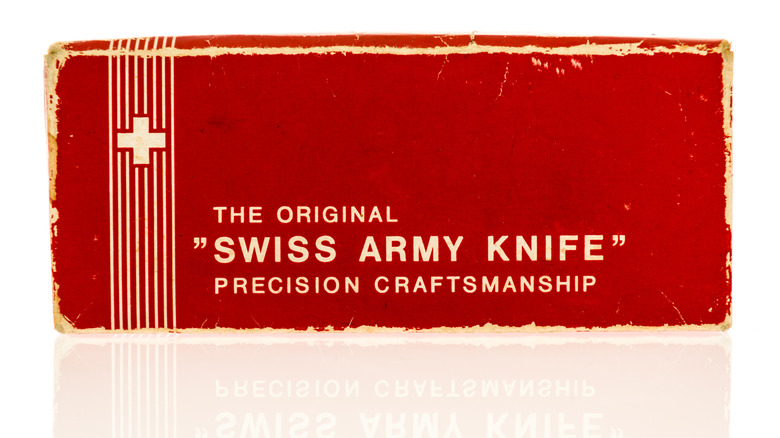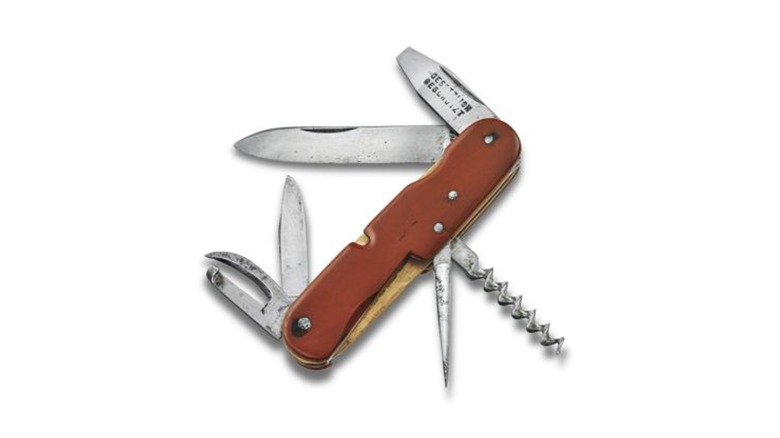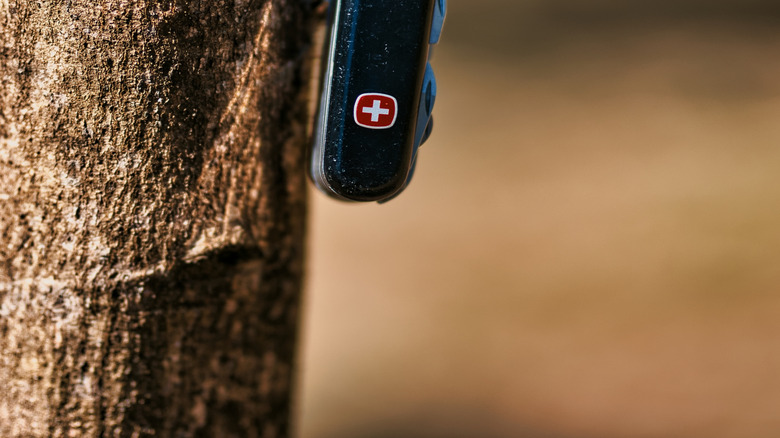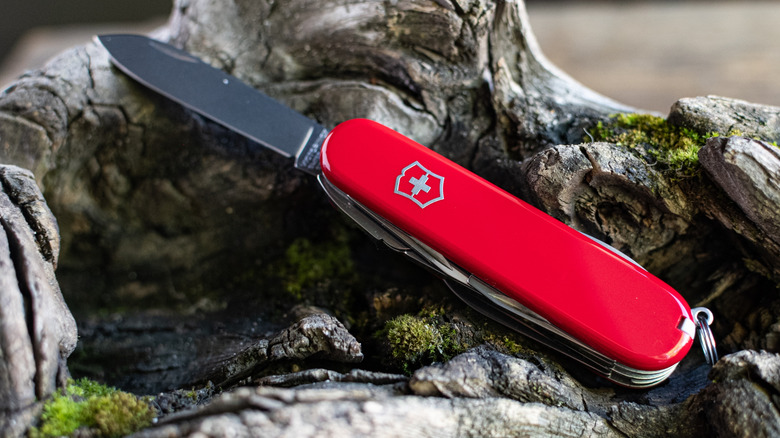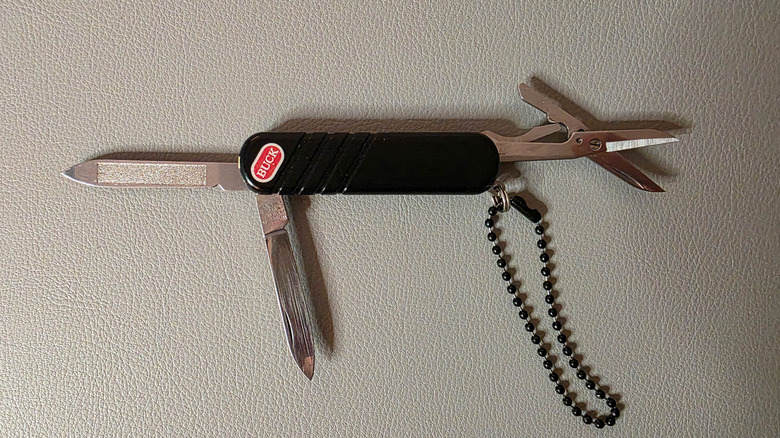Wenger Vs. Victorinox: What's The Difference Between The Swiss Army Knife Brands?
There's nothing quite like a classic Swiss Army Knife. The classic multitool, known in German as "offiziersmesser," or "officer's knife," has been in production since the early 1890s. But if you've tried to shop around for one today, you may have noticed something a bit perplexing. Two companies, Victorinox and Wenger, both appear to lay claim to the iconic military knife. While Victorinox claims to have "the original Swiss Army Knife," Wenger has used the term "genuine Swiss Army Knife." Even stranger knives bearing the Wenger name and logo are sold by Victorinox. What is the difference between these two famous knife brands, and what's the difference between their Swiss Army Knives?
To understand how these two brands got where they are today and what the difference between them is, we'll need to go back to pre-World War I Switzerland and trace their history all the way into the 21st century. What we find is a tale of Swiss innovation, the ways in which companies adapt to a changing world, and ultimately, a strange connection to one of the most horrific events of the post-modern era that changed everything for the world and for the Swiss Army Knife.
Our story starts at the twilight of the Gilded Age in a rural Swiss hamlet called Ibach, just south of Zurich. There, a man with simple dreams spawned a cutlery dynasty spanning over a century, and his knives would carve a path through history, including two world wars. By the time the story concluded, it would be his great-grandson who stood triumphant against a former knife-making foe. So, let's journey back to the beginning of the Swiss Army Knife.
Victorinox has been making Swiss Army Knives since the 1890s
Although knives similar to the Swiss Army Knife had existed for some time prior to being officially used by the Swiss Army, it wasn't until the waning years of the 19th century that the Army decided to officially make them part of a soldier's kit. The first version was sourced from Germany starting in 1886, but by 1891, the Swiss Army found a domestic cutler to supply the blades. Karl Elsner founded the Association of Swiss Master Cutlers, the company that would become Victorinox, in 1884. It was later renamed in honor of his mother, Victoria.
Elsner's first Swiss Army Knife, the standard issue for rank-and-file soldiers, had a blade, screwdriver, can opener, and reamer. Since, among other purposes, the intention in distributing them was to make it easy for soldiers to open their tinned rations, these tools suited the job. However, Elsner soon developed a more robust multitool that became known as the Officer's Knife. It added a second blade and a corkscrew and was issued in 1897. This was also the year the knife was patented as the Original Swiss Officer's and Sports Knife. Too many more versions of the knife to name were subsequently developed over the years.
In 1945, the Swiss Army Knife came to America in a major way when the U.S. Army ordered it for Post Exchange stores, and soldiers in Europe took them home as souvenirs after World War II. In 1977, the iconic original Swiss Army Knife design was placed on permanent exhibition in the Museum of Modern Art. So, where does Wenger enter the picture?
Wenger filled excess demand for Swiss Army Knives
Originally known as Paul Boechat & Cie, Wenger S.A. was founded in 1893, which happened to be precisely the right time for the fledgling company to be awarded a contract with the Swiss Army to produce Swiss Army knives. This, of course, made the company a direct competitor to Victorinox, which had been the first to supply the multitools.
Further complicating the relationship, Wenger originated in the French-speaking region of Switzerland known as Jura, while Victorinox represented the culturally diametric German-speaking region of Schwyz. In order to avoid the appearance of playing favorites, the Swiss Army began to divide the contracts equally. Starting in 1908, each company supplied roughly half of the Army's knives.
This explains why Victorinox uses the term "original" to market its knives, while Wenger used the term "genuine." Though the former beat Wenger only by a few years, both can lay claim to manufacturing the only authentic Swiss Army Knives. While other companies have and continue to make similar multitools, they cannot be considered Swiss Army Knives.
However, these historical distinctions matter little today. As the market took its course and the world changed around these classic cutlers, capitalism came calling. More than a century, after they began manufacturing their respective Swiss Army Knives, Victorinox and Wenger would find themselves wed by corporate merger.
Victorinox acquired Wenger in 2005
The tragic terror attacks of September 11, 2001 were an inflection point for the nation and the world, and they caused a cavalcade of consequences. Aside from a new age of government surveillance and overseas wars, more mundane chains of events spilled out in a butterfly effect. One such was the decline of the Swiss Army Knife market. Prior to 9/11, Swiss Army Knives saw a large number of sales from Duty-Free shops in airports. In the wake of the attacks, TSA security checkpoints were quickly erected in terminals across America, and countries around the globe beefed up security measures. Swiss Army Knives were banned from planes, and sales dipped severely as a result.
By 2005, Wenger was in danger of going under. Victorinox, watching with trepidation the success of Asian-made Swiss Army Knife replicas, agreed that year to acquire Wenger, unifying the two historic rivals. Victorinox director Carl Elsner was quoted in the Canadian Globe and Mail saying, "Keeping the Swiss cross in Swiss hands is the best way to move forward," and noting that the purchase was an effort to stave off international competitors.
For a time, both brands continued to make Swiss Army Knives. Today, though, you may have noticed that Wenger is more associated with its line of Swiss Gear backpacks and luggage than it is with knives. In the aftermath of the acquisition, there was a period of restructuring. So, let's examine how the two brands differ today.
Victorinox took over Wenger's knife business in 2013
After the 2005 purchase of Wenger by Victorinox, the two companies continued to make Swiss Army Knives and other cutlery for some time. But eight years later, in January 2013, that came to an end. Wenger had been developing new lifestyle and aventuring products, and having both brands operating in the knife market was creating unnecessary duplication and cannibalization. In a press release, Victorinox announced that it would henceforth integrate Wenger's knife business into its own. The company noted that customers were having a difficult time differentiating the two brands on store shelves.
Alleviating potential fears that Wenger's iconic designs were going the way of the dodo, Victorinox noted, "An assortment from the Wenger knife collection will be produced going forward under the brand name Victorinox." That explains why, today, you can still find a slim number of Wenger-branded knives sold by Victorinox. Those interested can still find pre-2013 Wenger Swiss Army Knives on auction and secondhand sites like eBay, as well as some specialty retailers. Otherwise, you'll have to trawl your local pawn and curio shops.
Wenger now specializes in wristwatches and travel gear, while Victorinox is a destination for authentically Swiss cutlery, now carrying on the tradition of the classic Swiss Army Knife by itself. The story of these two classic Swiss companies is one that follows the contours of a rapidly changing world over more than a century, from the verdant hillsides of 1890s Switzerland, through both World Wars, and through the tumultuous dawn of the new millennium. So, the next time you flip open one of these iconic blades, take a moment to appreciate the weight of that history in the palm of your hand.
Are there differences between Wenger and Victorinox knives?
While both Victorinox and Wenger made Swiss Army Knives before the former bought the latter, there were distinctions between their products, as both companies innovated in different directions. As noted by Gear Personal, the main Swiss Army Knives on offer were the Victorinox Classic and Wenger Esquire, which measured 58mm and 65mm respectively, with both available in a wide range of colors and materials. Today, multitools similar to the Esquire are available as part of the Victorinox Delemont line of products. Another model that gained popularity was the Wenger Backpacker, which included a wood saw, and was popular among scouts (as a boy scout, I carried one of these). The Victorinox equivalent is the Camper, a nearly identical design.
According to aftermarket Swiss Army Knife parts retailer Sak Parts, Wenger was known for thicker blades, which were often serrated. But perhaps the most significant distinction between the two brands was in their respective scissors. Where Victorinox opted for a replaceable spring, Wenger used a lever design.
I happen to own a Wenger SwissBuck Legend, a rare and retired 65mm collaboration with Buck from 1991 and discontinued in 1998. It features Wenger-designed scissors that were also found on the Esquire. They are serrated and self-sharpening, and therefore they still work like new three decades into its lifespan, even as the main, spearpoint blade of the Legend has dulled. The nail file still works like a dream too, so the Legend remains an essential in my toiletry bag. Despite being a collaboration with an American company, its tools are identical to the classic Esquire, and it is therefore a remarkably well preserved representation of a classic Wenger Swiss Army Knife.
